| Listing 1 - 10 of 31 | << page >> |
Sort by
|
Book
Year: 2004 Publisher: [Place of publication not identified] IEEE
Abstract | Keywords | Export | Availability | Bookmark
 Loading...
Loading...Choose an application
- Reference Manager
- EndNote
- RefWorks (Direct export to RefWorks)
Detectors --- Perceptrons --- Information theory
Book
Year: 2004 Publisher: [Place of publication not identified] IEEE
Abstract | Keywords | Export | Availability | Bookmark
 Loading...
Loading...Choose an application
- Reference Manager
- EndNote
- RefWorks (Direct export to RefWorks)
Detectors --- Perceptrons --- Information theory --- Mechanical Engineering --- Engineering & Applied Sciences --- Industrial & Management Engineering
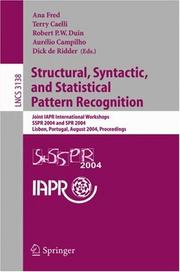

ISBN: 9783540278680 3540278680 3540225706 Year: 2004 Publisher: Berlin, Heidelberg : Springer Berlin Heidelberg : Imprint: Springer,
Abstract | Keywords | Export | Availability | Bookmark
 Loading...
Loading...Choose an application
- Reference Manager
- EndNote
- RefWorks (Direct export to RefWorks)
This volume contains all papers presented at SSPR 2004 and SPR 2004, hosted by the Instituto de Telecomunicac˜ ¸oes/Instituto Superior T´ ecnico, Lisbon, Portugal, August 18–20, 2004. This was the fourth time that the two workshops were held back-to-back. The SSPR was the tenth International Workshop on Structural and Synt- tic Pattern Recognition, and the SPR was the ?fth International Workshop on Statistical Techniques in Pattern Recognition. These workshops have traditi- ally been held in conjunction with ICPR (International Conference on Pattern Recognition), and are the major events for technical committees TC2 and TC1, respectively, of the International Association for Pattern Recognition (IAPR). The workshops were closely coordinated, being held in parallel, with plenary talks and a common session on hybrid systems. This was an attempt to resolve thedilemmaofhowto dealwiththeneedfornarrow-focusspecializedworkshops yet accommodate the presentation of new theories and techniques that blur the distinction between the statistical and the structural approaches. A total of 219 papers were received from many countries, with the subm- sion and reviewing processes being carried out separately for each workshop. A total of 59 papers were accepted for oral presentation and 64 for posters. In - dition, four invited speakers presented informative talks and overviews of their research. They were: Alberto Sanfeliu, from the Technical University of Cata- nia, Spain; Marco Gori, from the University of Siena, Italy; Nello Cristianini, from the University of California, USA; and Erkki Oja, from Helsinki University of Technology, Finland, winner of the 2004 Pierre Devijver Award.
Computer science. --- Computational complexity. --- Artificial intelligence. --- Computer graphics. --- Computer vision. --- Optical pattern recognition. --- Computer Science. --- Pattern Recognition. --- Discrete Mathematics in Computer Science. --- Artificial Intelligence (incl. Robotics). --- Computer Graphics. --- Image Processing and Computer Vision. --- Pattern recognition systems --- Electrical & Computer Engineering --- Engineering & Applied Sciences --- Electrical Engineering --- Computer science --- Image processing. --- Pattern recognition. --- Mathematics. --- Artificial Intelligence. --- Optical data processing --- Pattern perception --- Perceptrons --- Visual discrimination --- Machine vision --- Vision, Computer --- Artificial intelligence --- Image processing --- Automatic drafting --- Graphic data processing --- Graphics, Computer --- Computer art --- Graphic arts --- Electronic data processing --- Engineering graphics --- AI (Artificial intelligence) --- Artificial thinking --- Electronic brains --- Intellectronics --- Intelligence, Artificial --- Intelligent machines --- Machine intelligence --- Thinking, Artificial --- Bionics --- Cognitive science --- Digital computer simulation --- Logic machines --- Machine theory --- Self-organizing systems --- Simulation methods --- Fifth generation computers --- Neural computers --- Complexity, Computational --- Digital techniques --- Computer science—Mathematics. --- Optical data processing. --- Optical computing --- Visual data processing --- Integrated optics --- Photonics --- Computers --- Design perception --- Pattern recognition --- Form perception --- Perception --- Figure-ground perception --- Optical equipment --- Pattern perception.
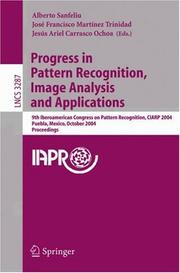
ISBN: 3540304630 3540235272 Year: 2004 Publisher: Berlin, Heidelberg : Springer Berlin Heidelberg : Imprint: Springer,
Abstract | Keywords | Export | Availability | Bookmark
 Loading...
Loading...Choose an application
- Reference Manager
- EndNote
- RefWorks (Direct export to RefWorks)
First of all, we want to congratulate two new research communities from M- ico and Brazil that have recently joined the Iberoamerican community and the International Association for Pattern Recognition. We believe that the series of congresses that started as the “Taller Iberoamericano de Reconocimiento de Patrones (TIARP)”, and later became the “Iberoamerican Congress on Pattern Recognition (CIARP)”, has contributed to these groupconsolidatione?orts. We hope that in the near future all the Iberoamerican countries will have their own groups and associations to promote our areas of interest; and that these congresses will serve as the forum for scienti?c research exchange, sharing of - pertise and new knowledge, and establishing contacts that improve cooperation between research groups in pattern recognition and related areas. CIARP 2004 (9th Iberoamerican Congress on Pattern Recognition) was the ninthinaseriesofpioneeringcongressesonpatternrecognitionintheIberoam- ican community. As in the previous year, CIARP 2004 also included worldwide participation. It took place in Puebla, Mexico. The aim of the congress was to promote and disseminate ongoing research and mathematical methods for pattern recognition, image analysis, and applications in such diverse areas as computer vision, robotics, industry, health, entertainment, space exploration, telecommunications, data mining, document analysis,and natural languagep- cessing and recognition, to name a few.
Computer science. --- Artificial intelligence. --- Computer vision. --- Optical pattern recognition. --- Computer Science. --- Pattern Recognition. --- Image Processing and Computer Vision. --- Artificial Intelligence (incl. Robotics). --- Pattern recognition systems --- Image processing --- Electrical & Computer Engineering --- Engineering & Applied Sciences --- Electrical Engineering --- Image processing. --- Pattern recognition. --- Design perception --- Pattern recognition --- Form perception --- Perception --- Figure-ground perception --- Pictorial data processing --- Picture processing --- Processing, Image --- Imaging systems --- Optical data processing --- AI (Artificial intelligence) --- Artificial thinking --- Electronic brains --- Intellectronics --- Intelligence, Artificial --- Intelligent machines --- Machine intelligence --- Thinking, Artificial --- Bionics --- Cognitive science --- Digital computer simulation --- Electronic data processing --- Logic machines --- Machine theory --- Self-organizing systems --- Simulation methods --- Fifth generation computers --- Neural computers --- Informatics --- Science --- Artificial Intelligence. --- Machine vision --- Vision, Computer --- Artificial intelligence --- Pattern perception --- Perceptrons --- Visual discrimination --- Optical data processing. --- Optical computing --- Visual data processing --- Integrated optics --- Photonics --- Computers --- Optical equipment --- Pattern perception.
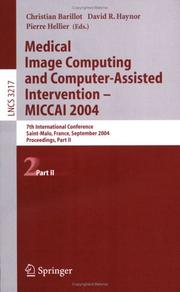
ISBN: 3540301364 3540229779 Year: 2004 Publisher: Berlin, Heidelberg : Springer Berlin Heidelberg : Imprint: Springer,
Abstract | Keywords | Export | Availability | Bookmark
 Loading...
Loading...Choose an application
- Reference Manager
- EndNote
- RefWorks (Direct export to RefWorks)
The 7th International Conference on Medical Imaging and Computer Assisted Intervention, MICCAI 2004, was held in Saint-Malo, Brittany, France at the “Palais du Grand Large” conference center, September 26–29, 2004. The p- posaltohostMICCAI2004wasstronglyencouragedandsupportedbyIRISA, Rennes. IRISA is a publicly funded national research laboratory with a sta? of 370,including150full-timeresearchscientistsorteachingresearchscientistsand 115 postgraduate students. INRIA, the CNRS, and the University of Rennes 1 are all partners in this mixed research unit, and all three organizations were helpful in supporting MICCAI. MICCAI has become a premier international conference with in-depth - pers on the multidisciplinary ?elds of medical image computing, comput- assisted intervention and medical robotics. The conference brings together cl- icians, biological scientists, computer scientists, engineers, physicists and other researchers and o?ers them a forum to exchange ideas in these exciting and rapidly growing ?elds. The impact of MICCAI increases each year and the quality and quantity of submitted papers this year was very impressive. We received a record 516 full submissions (8 pages in length) and 101 short communications (2 pages) from 36 di?erent countries and 5 continents (see ?gures below). All submissions were reviewed by up to 4 external reviewers from the Scienti?c Review C- mittee and a primary reviewer from the Program Committee. All reviews were then considered by the MICCAI 2004 Program Committee, resulting in the acceptance of 235 full papers and 33 short communications.
Medicine. --- Radiology. --- Internal medicine. --- Artificial intelligence. --- Computer graphics. --- Image processing. --- Pattern recognition. --- Medicine & Public Health. --- Internal Medicine. --- Image Processing and Computer Vision. --- Pattern Recognition. --- Computer Graphics. --- Artificial Intelligence (incl. Robotics). --- Imaging / Radiology. --- Medicine --- Diagnostic imaging --- Data processing --- Computer vision. --- Optical pattern recognition. --- Radiology, Medical. --- Artificial Intelligence. --- Clinical radiology --- Radiology, Medical --- Radiology (Medicine) --- Medical physics --- AI (Artificial intelligence) --- Artificial thinking --- Electronic brains --- Intellectronics --- Intelligence, Artificial --- Intelligent machines --- Machine intelligence --- Thinking, Artificial --- Bionics --- Cognitive science --- Digital computer simulation --- Electronic data processing --- Logic machines --- Machine theory --- Self-organizing systems --- Simulation methods --- Fifth generation computers --- Neural computers --- Automatic drafting --- Graphic data processing --- Graphics, Computer --- Computer art --- Graphic arts --- Engineering graphics --- Image processing --- Optical data processing --- Pattern perception --- Perceptrons --- Visual discrimination --- Machine vision --- Vision, Computer --- Artificial intelligence --- Pattern recognition systems --- Medicine, Internal --- Digital techniques --- Health Workforce --- Optical data processing. --- Radiological physics --- Physics --- Radiation --- Design perception --- Pattern recognition --- Form perception --- Perception --- Figure-ground perception --- Optical computing --- Visual data processing --- Integrated optics --- Photonics --- Computers --- Optical equipment --- Pattern perception.

ISBN: 3540301267 3540232400 Year: 2004 Publisher: Berlin, Heidelberg : Springer Berlin Heidelberg : Imprint: Springer,
Abstract | Keywords | Export | Availability | Bookmark
 Loading...
Loading...Choose an application
- Reference Manager
- EndNote
- RefWorks (Direct export to RefWorks)
ICIAR 2004, the International Conference on Image Analysis and Recognition, was the ?rst ICIAR conference, and was held in Porto, Portugal. ICIAR will be organized annually, and will alternate between Europe and North America. ICIAR 2005 will take place in Toronto, Ontario, Canada. The idea of o?ering these conferences came as a result of discussion between researchers in Portugal and Canada to encourage collaboration and exchange, mainly between these two countries, but also with the open participation of other countries, addressing recent advances in theory, methodology and applications. The response to the call for papers for ICIAR 2004 was very positive. From 316 full papers submitted, 210 were accepted (97 oral presentations, and 113 - sters). The review process was carried out by the Program Committee members and other reviewers; all are experts in various image analysis and recognition areas. Each paper was reviewed by at least two reviewing parties. The high q- lity of the papers in these proceedings is attributed ?rst to the authors, and second to the quality of the reviews provided by the experts. We would like to thank the authors for responding to our call, and we wholeheartedly thank the reviewers for their excellent work in such a short amount of time. We are espe- ally indebted to the Program Committee for their e?orts that allowed us to set up this publication. We were very pleased to be able to include in the conference, Prof. Murat KuntfromtheSwissFederalInstituteofTechnology,andProf. Mario ´ Figueiredo, oftheInstitutoSuperiorT´ ecnico,inPortugal.
Computer science. --- Text processing (Computer science. --- Computer graphics. --- Computer vision. --- Optical pattern recognition. --- Computer Science. --- Image Processing and Computer Vision. --- Document Preparation and Text Processing. --- Computer Graphics. --- Pattern Recognition. --- Image analysis --- Optical pattern recognition --- Text processing (Computer science). --- Image processing. --- Pattern recognition. --- Natural language processing (Computer science). --- Natural Language Processing (NLP). --- Machine vision --- Vision, Computer --- Artificial intelligence --- Image processing --- Pattern recognition systems --- Optical data processing --- Pattern perception --- Perceptrons --- Visual discrimination --- NLP (Computer science) --- Electronic data processing --- Human-computer interaction --- Semantic computing --- Automatic drafting --- Graphic data processing --- Graphics, Computer --- Computer art --- Graphic arts --- Engineering graphics --- Digital techniques --- Optical data processing. --- Optical computing --- Visual data processing --- Bionics --- Integrated optics --- Photonics --- Computers --- Design perception --- Pattern recognition --- Form perception --- Perception --- Figure-ground perception --- Optical equipment --- Pattern perception. --- Natural language processing (Computer science)

ISBN: 3540301259 3540232230 Year: 2004 Publisher: Berlin, Heidelberg : Springer Berlin Heidelberg : Imprint: Springer,
Abstract | Keywords | Export | Availability | Bookmark
 Loading...
Loading...Choose an application
- Reference Manager
- EndNote
- RefWorks (Direct export to RefWorks)
ICIAR 2004, the International Conference on Image Analysis and Recognition, was the ?rst ICIAR conference, and was held in Porto, Portugal. ICIAR will be organized annually, and will alternate between Europe and North America. ICIAR 2005 will take place in Toronto, Ontario, Canada. The idea of o?ering these conferences came as a result of discussion between researchers in Portugal and Canada to encourage collaboration and exchange, mainly between these two countries, but also with the open participation of other countries, addressing recent advances in theory, methodology and applications. The response to the call for papers for ICIAR 2004 was very positive. From 316 full papers submitted, 210 were accepted (97 oral presentations, and 113 - sters). The review process was carried out by the Program Committee members and other reviewers; all are experts in various image analysis and recognition areas. Each paper was reviewed by at least two reviewing parties. The high q- lity of the papers in these proceedings is attributed ?rst to the authors, and second to the quality of the reviews provided by the experts. We would like to thank the authors for responding to our call, and we wholeheartedly thank the reviewers for their excellent work in such a short amount of time. We are espe- ally indebted to the Program Committee for their e?orts that allowed us to set up this publication. We were very pleased to be able to include in the conference, Prof. Murat KuntfromtheSwissFederalInstituteofTechnology,andProf. Mario ´ Figueiredo, oftheInstitutoSuperiorT´ ecnico,inPortugal.
Computer science. --- Text processing (Computer science. --- Computer graphics. --- Computer vision. --- Optical pattern recognition. --- Computer Science. --- Image Processing and Computer Vision. --- Document Preparation and Text Processing. --- Computer Graphics. --- Pattern Recognition. --- Image analysis --- Optical pattern recognition --- Applied Physics --- Engineering & Applied Sciences --- Text processing (Computer science). --- Image processing. --- Pattern recognition. --- Natural language processing (Computer science). --- Natural Language Processing (NLP). --- Automatic drafting --- Graphic data processing --- Graphics, Computer --- Computer art --- Graphic arts --- Electronic data processing --- Engineering graphics --- Image processing --- Optical data processing --- Pattern perception --- Perceptrons --- Visual discrimination --- NLP (Computer science) --- Artificial intelligence --- Human-computer interaction --- Semantic computing --- Machine vision --- Vision, Computer --- Pattern recognition systems --- Digital techniques --- Optical data processing. --- Design perception --- Pattern recognition --- Form perception --- Perception --- Figure-ground perception --- Optical computing --- Visual data processing --- Bionics --- Integrated optics --- Photonics --- Computers --- Optical equipment --- Natural language processing (Computer science) --- Pattern perception.
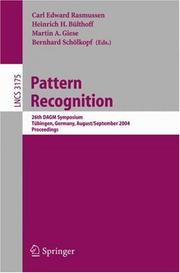
ISBN: 3540229450 3540286497 Year: 2004 Publisher: Berlin, Heidelberg : Springer Berlin Heidelberg : Imprint: Springer,
Abstract | Keywords | Export | Availability | Bookmark
 Loading...
Loading...Choose an application
- Reference Manager
- EndNote
- RefWorks (Direct export to RefWorks)
We are delighted to present the proceedings of DAGM 2004, and wish to - press our gratitude to the many people whose e?orts made the success of the conference possible. We received 146 contributions of which we were able to - cept 22 as oral presentations and 48 as posters. Each paper received 3 reviews, upon which decisions were based. We are grateful for the dedicated work of the 38 members of the program committee and the numerous referees. The careful review process led to the exciting program which we are able to present in this volume. Among the highlights of the meeting were the talks of our four invited spe- ers, renowned experts in areas spanning learning in theory, in vision and in robotics: – William T. Freeman, Arti?cial Intelligence Laboratory, MIT: Sharing F- tures for Multi-class Object Detection – PietroPerona,Caltech:TowardsUnsupervisedLearningofObjectCategories – StefanSchaal,DepartmentofComputerScience,UniversityofSouthernC- ifornia: Real-Time Statistical Learning for Humanoid Robotics – Vladimir Vapnik, NEC Research Institute: Empirical Inference WearegratefulforeconomicsupportfromHondaResearchInstituteEurope, ABW GmbH, Transtec AG, DaimlerChrysler, and Stemmer Imaging GmbH, which enabled us to ?nance best paper prizes and a limited number of travel grants. Many thanks to our local support Sabrina Nielebock and Dagmar Maier, who dealt with the unimaginably diverse range of practical tasks involved in planning a DAGM symposium. Thanks to Richard van de Stadt for providing excellent software and support for handling the reviewing process. A special thanks goes to Jeremy Hill, who wrote and maintained the conference website.
Image processing --- Optical pattern recognition --- Digital techniques --- Pattern Recognition. --- Image Processing and Computer Vision. --- Computer Graphics. --- Computer science. --- Algorithms. --- Artificial intelligence. --- Computer graphics. --- Image processing. --- Pattern recognition. --- Computer Science. --- Artificial Intelligence (incl. Robotics). --- Algorithm Analysis and Problem Complexity. --- Optical pattern recognition. --- Computer vision. --- Computer software. --- Artificial Intelligence. --- Software, Computer --- Computer systems --- Automatic drafting --- Graphic data processing --- Graphics, Computer --- Computer art --- Graphic arts --- Electronic data processing --- Engineering graphics --- AI (Artificial intelligence) --- Artificial thinking --- Electronic brains --- Intellectronics --- Intelligence, Artificial --- Intelligent machines --- Machine intelligence --- Thinking, Artificial --- Bionics --- Cognitive science --- Digital computer simulation --- Logic machines --- Machine theory --- Self-organizing systems --- Simulation methods --- Fifth generation computers --- Neural computers --- Machine vision --- Vision, Computer --- Artificial intelligence --- Pattern recognition systems --- Optical data processing --- Pattern perception --- Perceptrons --- Visual discrimination --- Optical data processing. --- Optical computing --- Visual data processing --- Integrated optics --- Photonics --- Computers --- Design perception --- Pattern recognition --- Form perception --- Perception --- Figure-ground perception --- Algorism --- Algebra --- Arithmetic --- Optical equipment --- Foundations --- Pattern perception.
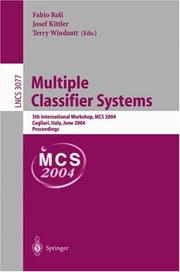
ISBN: 3540221441 9786610307784 1280307781 354025966X Year: 2004 Publisher: Berlin, Heidelberg : Springer Berlin Heidelberg : Imprint: Springer,
Abstract | Keywords | Export | Availability | Bookmark
 Loading...
Loading...Choose an application
- Reference Manager
- EndNote
- RefWorks (Direct export to RefWorks)
The fusion of di?erent information sourcesis a persistent and intriguing issue. It hasbeenaddressedforcenturiesinvariousdisciplines,includingpoliticalscience, probability and statistics, system reliability assessment, computer science, and distributed detection in communications. Early seminal work on fusion was c- ried out by pioneers such as Laplace and von Neumann. More recently, research activities in information fusion have focused on pattern recognition. During the 1990s,classi?erfusionschemes,especiallyattheso-calleddecision-level,emerged under a plethora of di?erent names in various scienti?c communities, including machine learning, neural networks, pattern recognition, and statistics. The d- ferent nomenclatures introduced by these communities re?ected their di?erent perspectives and cultural backgrounds as well as the absence of common forums and the poor dissemination of the most important results. In 1999, the ?rst workshop on multiple classi?er systems was organized with the main goal of creating a common international forum to promote the diss- ination of the results achieved in the diverse communities and the adoption of a common terminology, thus giving the di?erent perspectives and cultural ba- grounds some concrete added value. After ?ve meetings of this workshop, there is strong evidence that signi?cant steps have been made towards this goal. - searchers from these diverse communities successfully participated in the wo- shops, and world experts presented surveys of the state of the art from the perspectives of their communities to aid cross-fertilization.
Machine learning --- Neural networks (Computer science) --- Pattern perception --- Pattern Recognition. --- Image Processing and Computer Vision. --- Computation by Abstract Devices. --- Computer science. --- Computers. --- Artificial intelligence. --- Image processing. --- Pattern recognition. --- Computer Science. --- Artificial Intelligence (incl. Robotics). --- Design perception --- Pattern recognition --- Form perception --- Perception --- Figure-ground perception --- Pictorial data processing --- Picture processing --- Processing, Image --- Imaging systems --- Optical data processing --- AI (Artificial intelligence) --- Artificial thinking --- Electronic brains --- Intellectronics --- Intelligence, Artificial --- Intelligent machines --- Machine intelligence --- Thinking, Artificial --- Bionics --- Cognitive science --- Digital computer simulation --- Electronic data processing --- Logic machines --- Machine theory --- Self-organizing systems --- Simulation methods --- Fifth generation computers --- Neural computers --- Automatic computers --- Automatic data processors --- Computer hardware --- Computing machines (Computers) --- Electronic calculating-machines --- Electronic computers --- Hardware, Computer --- Computer systems --- Cybernetics --- Calculators --- Cyberspace --- Informatics --- Science --- Optical pattern recognition. --- Computer vision. --- Artificial Intelligence. --- Machine vision --- Vision, Computer --- Artificial intelligence --- Image processing --- Pattern recognition systems --- Perceptrons --- Visual discrimination --- Optical data processing. --- Optical computing --- Visual data processing --- Integrated optics --- Photonics --- Computers --- Optical equipment --- Pattern perception.
Book
ISBN: 128030748X 9786610307487 3540246738 Year: 2004 Publisher: Berlin, Heidelberg : Springer Berlin Heidelberg : Imprint: Springer,
Abstract | Keywords | Export | Availability | Bookmark
 Loading...
Loading...Choose an application
- Reference Manager
- EndNote
- RefWorks (Direct export to RefWorks)
Welcome to the proceedings of the 8th European Conference on Computer - sion! Following a very successful ECCV 2002, the response to our call for papers was almost equally strong – 555 papers were submitted. We accepted 41 papers for oral and 149 papers for poster presentation. Several innovations were introduced into the review process. First, the n- ber of program committee members was increased to reduce their review load. We managed to assign to program committee members no more than 12 papers. Second, we adopted a paper ranking system. Program committee members were asked to rank all the papers assigned to them, even those that were reviewed by additional reviewers. Third, we allowed authors to respond to the reviews consolidated in a discussion involving the area chair and the reviewers. Fourth, thereports,thereviews,andtheresponsesweremadeavailabletotheauthorsas well as to the program committee members. Our aim was to provide the authors with maximal feedback and to let the program committee members know how authors reacted to their reviews and how their reviews were or were not re?ected in the ?nal decision. Finally, we reduced the length of reviewed papers from 15 to 12 pages. ThepreparationofECCV2004wentsmoothlythankstothee?ortsofthe- ganizing committee, the area chairs, the program committee, and the reviewers. We are indebted to Anders Heyden, Mads Nielsen, and Henrik J. Nielsen for passing on ECCV traditions and to Dominique Asselineau from ENST/TSI who kindly provided his GestRFIA conference software. We thank Jan-Olof Eklundh and Andrew Zisserman for encouraging us to organize ECCV 2004 in Prague.
Computer vision --- Computer vision. --- Optical pattern recognition. --- Computer graphics. --- Artificial intelligence. --- Image Processing and Computer Vision. --- Pattern Recognition. --- Computer Graphics. --- Artificial Intelligence. --- AI (Artificial intelligence) --- Artificial thinking --- Electronic brains --- Intellectronics --- Intelligence, Artificial --- Intelligent machines --- Machine intelligence --- Thinking, Artificial --- Bionics --- Cognitive science --- Digital computer simulation --- Electronic data processing --- Logic machines --- Machine theory --- Self-organizing systems --- Simulation methods --- Fifth generation computers --- Neural computers --- Automatic drafting --- Graphic data processing --- Graphics, Computer --- Computer art --- Graphic arts --- Engineering graphics --- Image processing --- Optical data processing --- Pattern perception --- Perceptrons --- Visual discrimination --- Machine vision --- Vision, Computer --- Artificial intelligence --- Pattern recognition systems --- Digital techniques --- Optical data processing. --- Pattern recognition. --- Design perception --- Pattern recognition --- Form perception --- Perception --- Figure-ground perception --- Optical computing --- Visual data processing --- Integrated optics --- Photonics --- Computers --- Optical equipment --- Pattern perception.
| Listing 1 - 10 of 31 | << page >> |
Sort by
|

 Search
Search Feedback
Feedback About UniCat
About UniCat  Help
Help News
News